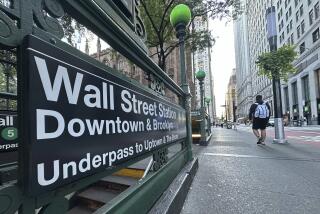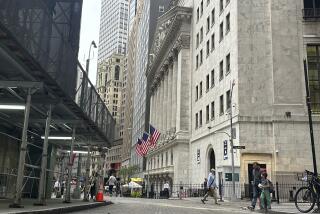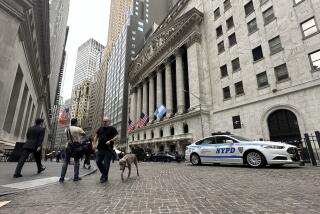FINANCIAL MARKETS : Gold Prices Soar to Year’s Highest Level : Market Overview
* Gold prices surged to their highest level of the year as commodity funds poured money into precious metals.
* A late ripple of buying sent blue chip stocks slightly higher, but a fresh whiff of inflation kept investors mostly on the defensive.
* In credit markets, long-term bond yields moved higher again.
Commodities
Market analysts said there was no clear fundamental reason for the precious metal’s rally and cautioned that prices could quickly reverse course without broader support.
On the Commodity Exchange in New York, gold for current delivery rose $4.80 an ounce to $337.00.
May silver soared 14.7 cents to $3.90 an ounce, the highest level since Nov. 5.
On the New York Mercantile Exchange, April platinum leaped $5.10 to $363.70 an ounce.
The high-volume buying began in Europe overnight. The overseas buying was prompted by the German central bank’s announcement that it will stick to its policy of easing interest rates in small steps, in part to avoid driving up the value of the U.S. dollar, said Peter Cardillo, research director with Westfalia Investments Inc. in New York.
A stronger dollar makes investments denominated in the U.S. currency more attractive, which weakens investment demand for gold.
The surge on U.S. markets as metal prices moved above longstanding resistance points, including $3.80 in the silver market, brought in more buyers.
Fund managers, who tend to base trading decisions on the market’s behavior rather than external factors, were big buyers, analysts said.
“They all went like dominoes in a row once the market got rolling,” said Martin Reichenberg, manager of trading services for Pegasus Econometric Group in Hoboken, N.J.
Elsewhere in the commodities market, light, sweet crude oil for May delivery slipped 1 cent to $20.28 a barrel on the New York Mercantile Exchange.
Stocks
The market traded in narrow, mostly negative, ranges throughout most of the day, as investors took a cautious view ahead of the quarter’s end today.. But reports late in the session that a top health care adviser to President Clinton said he doubted that the Administration would impose price controls on drugs spurred buying in medical stocks.
The Dow Jones industrial average closed up 2.17 points to 3,457.27. In the broader market, advancing issues outnumbered declines by about 9 to 8 on the New York Stock Exchange.
Volume on the floor of the Big Board came to 231.19 million shares, up from 201.57 million in the previous session.
The NASDAQ index shot up 5.49 points to 686.25, buoyed by a rally in technology companies.
Gold mining company stocks advanced on the surging price of gold. “Gold stocks have done very well in the past couple of weeks,” said Guy Truicko, a portfolio manager at Unity Management Inc. “Obviously, people are worried about inflation.”
Federal Reserve Gov. Lawrence Lindsey told reporters that the central bank continues to watch inflation numbers closely and that any increase in the core rate would be of concern.
But he did say “any inflationary number makes me concerned.”
Among the trading highlights:
* Among gold stocks, Homestake Mining gained 1 1/4 to 14 3/8, and Newmont Gold climbed 2 5/8 to 40 1/8.
* Shares of Fisher Price lost 3 1/8 to 20 3/8 after the company said it expects to post a loss in the first quarter.
* Sun Microsystems added 1 3/8 to 29 5/9 on news that it will write a version of its operating system software for a computer being jointly developed with three other companies.
* Amgen rose 2 to 37. Dillon Read upgraded its rating and raised its 1993 earnings estimate.
* Among drug stocks, Marion-Merrell Dow added 1 1/2 to 19 1/4, Merck was up 1 3/8 to 35 7/8, Johnson & Johnson rose 2 to 42, and Pfizer gained 2 1/2 to 62 1/2.
* Microsoft, aided by positive comments from Goldman Sachs, rose 4 to 91.
Overseas, Frankfurt stock prices ended higher after a late spurt in buying. The 30-share DAX average ended 10.15 points up at 1,685.07. Share prices were higher on the London stock exchange. The Financial Times 100-share average rose 14.5 points to close at 2,861.0 points. Tokyo’s 225-share Nikkei average fell 85.22 points to 18,963.16.
Other Markets
The Treasury’s 30-year bond, ordinarily a key indicator of broader credit market interest rates, rose in contrast with falling rates of short- and intermediate-term notes.
Prices of Treasury notes and bills were driven higher by a surge in buying by municipalities and a report of weaker consumer confidence in the U.S. economic recovery.
The yield for the Treasury’s 30-year bond rose to 6.91% from Monday’s 6.89%. The bond’s price, which falls when yields rise, was down 7/32 point, or $2.19 per $1,000 in face value.
The mixed performance reflected a market dominated by two divergent views, one of rising inflation and the other of a lackluster economic recovery.
Economists said buyers who held to the poor economy outlook abandoned the long bond because shorter-term maturities seem more attractive.
Prominent for these traders was a Conference Board survey that consumer confidence in the economy fell in March for the third consecutive month as Americans continued to worry about job security.
At the same time, recent reports of rising inflation have hurt prices of long-term maturities, which are most vulnerable to higher consumer prices because their value can be eroded over a period of many years.
The federal funds rate, the interest on overnight loans between banks, was 2.875%, down from 3.375% late Monday.
Meanwhile, the dollar hit a two-month low against the German mark,
The dollar closed at 1.6172 marks in New York trading, down from 1.6268 marks Monday.
Trading in yen was extremely quiet, closing in New York at 116.55 Japanese yen, down from late Monday’s 116.85.
Market Roundup, D6
More to Read
Inside the business of entertainment
The Wide Shot brings you news, analysis and insights on everything from streaming wars to production — and what it all means for the future.
You may occasionally receive promotional content from the Los Angeles Times.










